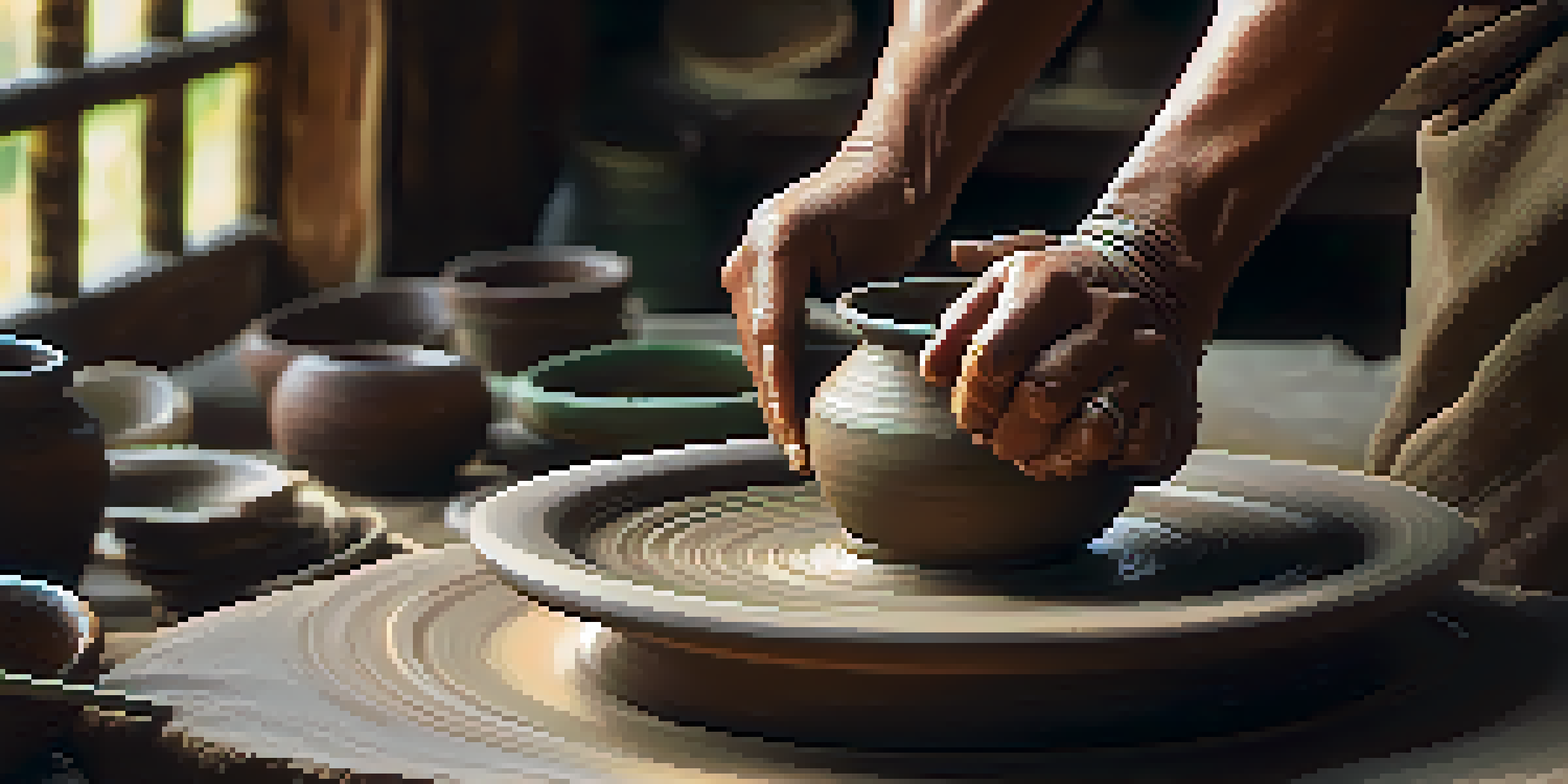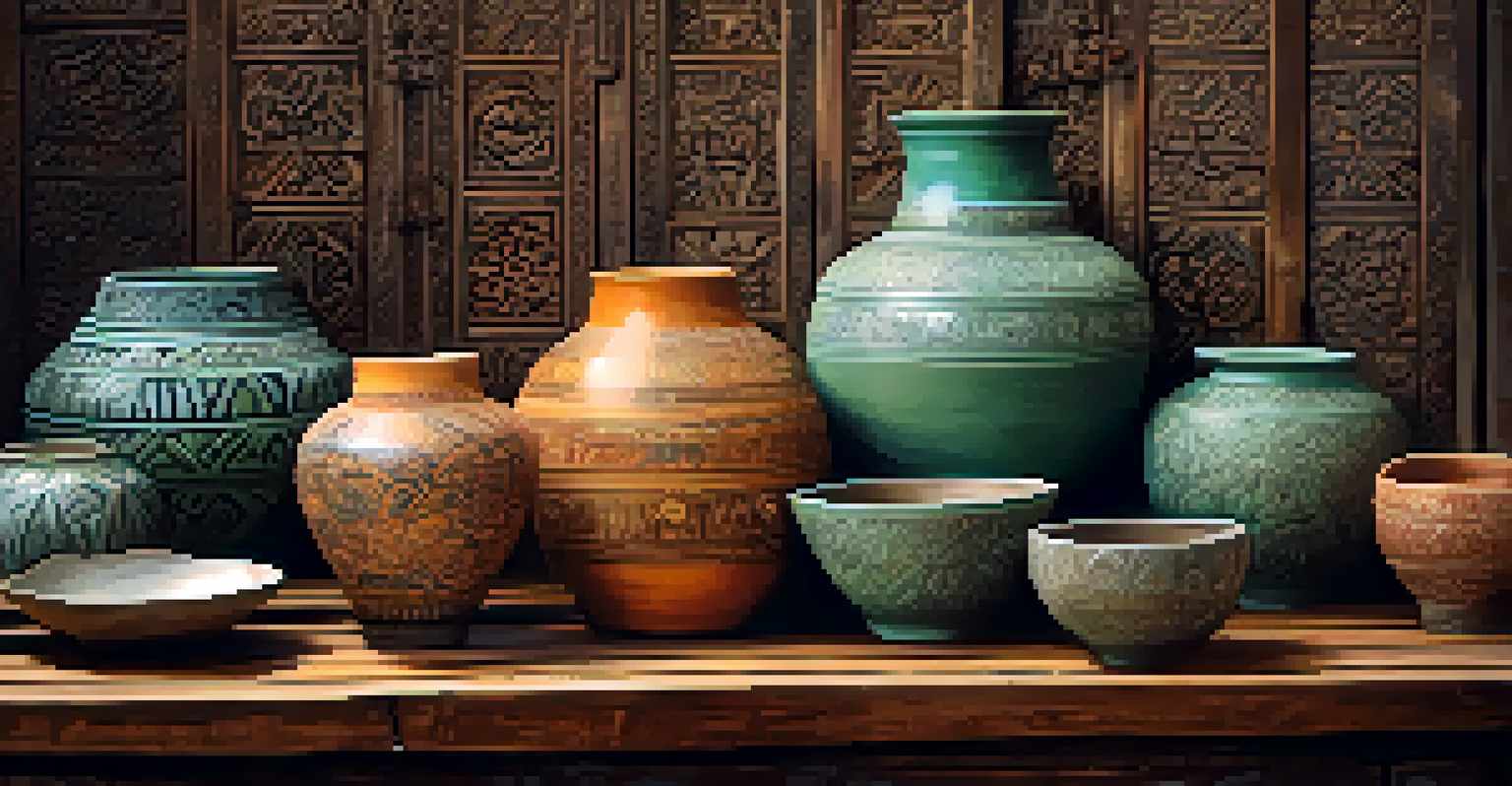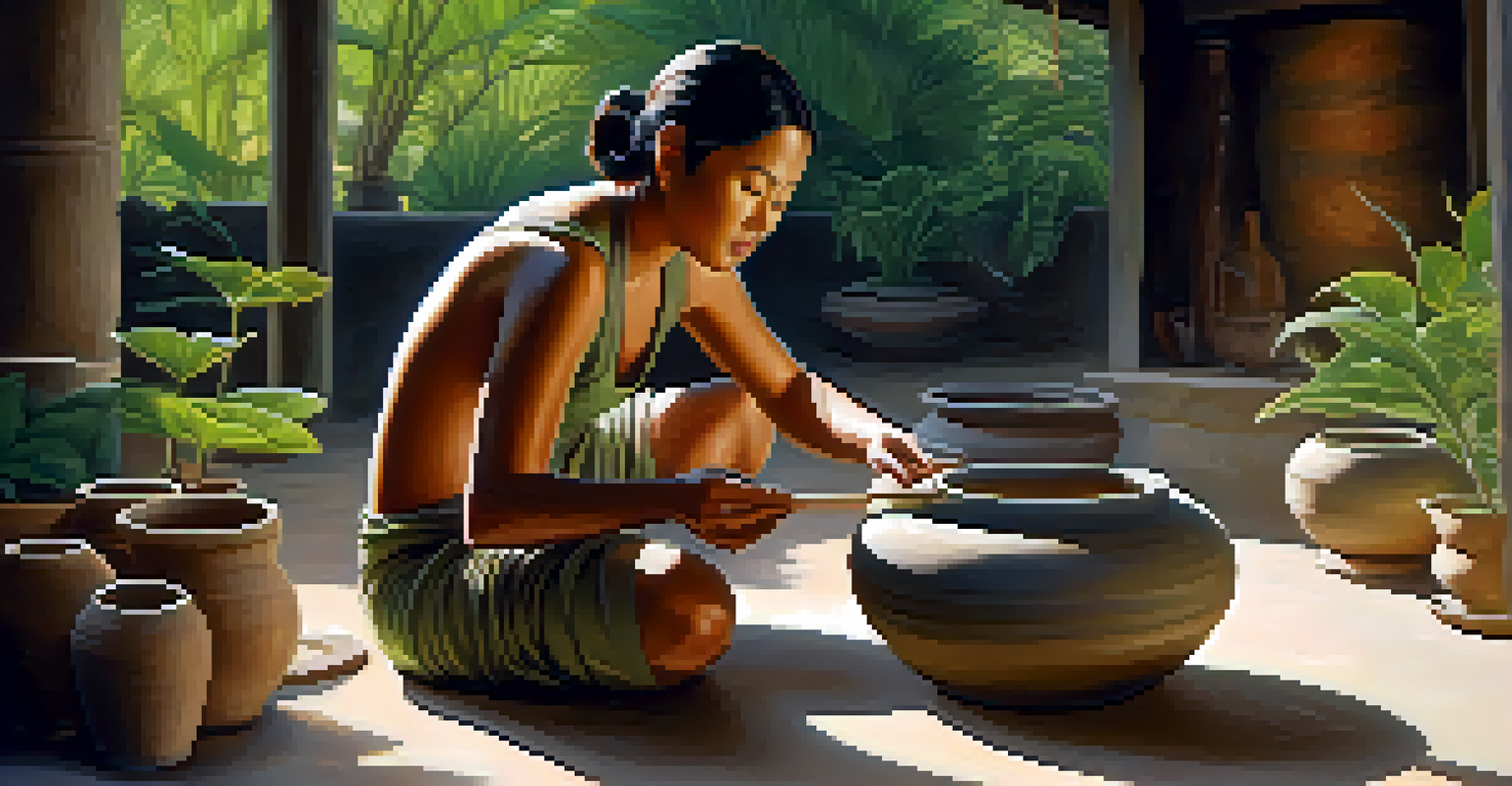A Deep Dive into Pottery: Thai Techniques and Styles

An Introduction to Thai Pottery and Its Significance
Thai pottery boasts a rich history that dates back thousands of years, deeply intertwined with the culture and traditions of Thailand. It reflects the creativity and craftsmanship of local artisans, making it not just functional but also a form of artistic expression. Understanding this art form means appreciating how it connects communities and showcases Thailand's heritage.
Pottery is a silent ambassador of a culture, carrying the traditions and stories of its people in every curve and color.
In Thailand, pottery has been used for various purposes, from everyday household items to ceremonial pieces. Each piece tells a story, often influenced by regional characteristics and the materials available. The evolution of Thai pottery over time illustrates the blend of indigenous styles with foreign influences, particularly from neighboring countries and cultures.
Today, Thai pottery continues to thrive, with artisans preserving traditional techniques while also embracing modern innovations. This blend of the old and the new ensures that Thai pottery remains relevant and appreciated in both domestic and international markets. As we dive deeper into the techniques and styles, you'll see how this art form represents the soul of Thai culture.
Traditional Thai Pottery Techniques: A Closer Look
Traditional Thai pottery techniques vary significantly from region to region, each offering unique methods that have been passed down through generations. One prominent technique is hand-throwing, where potters skillfully shape clay on a spinning wheel, creating symmetrical forms. This method requires years of practice, and the potter's touch is crucial in ensuring the final product is both beautiful and functional.

Another essential technique is coiling, where long ropes of clay are stacked and blended to form larger pieces. This method allows for greater creativity and intricate designs, often resulting in stunning vases and pots that showcase the potter's artistic flair. Coiling is particularly popular in rural areas, where artisans have adapted their techniques to suit local needs and resources.
Thai Pottery: A Cultural Treasure
Thai pottery reflects the country's rich heritage and artistic expression, connecting communities through its functional and ceremonial pieces.
Furthermore, glazing is a critical step in the pottery-making process that enhances both the aesthetics and durability of the pieces. Thai potters often use natural materials to create unique glazes that reflect local landscapes and cultural motifs. The combination of these techniques results in pottery that is not only visually striking but also rich in cultural significance.
Regional Styles: Northern vs. Southern Thai Pottery
Thai pottery is distinguished by its regional styles, with Northern and Southern Thailand showcasing distinct characteristics. Northern Thai pottery, particularly from the city of Chiang Mai, is known for its intricate designs and vibrant glazes. The use of celadon, a jade-green glaze, is a hallmark of this region, often seen in decorative items and tableware that embody the area's artistic traditions.
Art is the most beautiful of all lies; it tells the truth of our existence, reflecting the world in ways we cannot always express.
In contrast, Southern Thai pottery tends to focus on functional ware, with simpler designs that serve everyday purposes. This style emphasizes sturdiness and practicality, often using darker clay and less elaborate glazing techniques. The pottery from this region is highly valued for its utility, reflecting the lifestyle of the communities that produce it.
Despite these differences, both regions share a common reverence for the craft, with artisans dedicated to preserving their unique styles. This regional diversity enriches the overall tapestry of Thai pottery, allowing for a wide range of artistic expressions that cater to both local and international tastes.
The Role of Nature in Thai Pottery Making
Nature plays a pivotal role in Thai pottery, influencing the materials used and the designs created. The clay itself, often sourced locally, varies in texture and color, directly affecting the final product's appearance. Potters have an intimate relationship with their natural surroundings, selecting materials that resonate with the landscapes of their regions.
Moreover, natural elements inspire many designs and motifs seen in Thai pottery. Floral patterns, animal shapes, and even landscapes are commonly incorporated, reflecting the beauty of the Thai environment. This connection to nature not only enriches the artistic quality of the pottery but also keeps the cultural storytelling alive.
Traditional Techniques and Styles
Distinct regional styles and techniques, such as hand-throwing and coiling, showcase the unique craftsmanship that has been passed down through generations.
Additionally, many artisans are now adopting sustainable practices, ensuring that their methods are environmentally friendly. By using natural materials and techniques that minimize waste, they honor the earth while continuing to produce stunning works of art. This commitment to sustainability is becoming increasingly important in the world of pottery, aligning tradition with modern values.
Cultural Influences on Thai Pottery Styles
Thai pottery is a captivating reflection of the country's rich cultural tapestry, shaped by various influences throughout history. From ancient times, trade routes introduced foreign techniques and styles that blended seamlessly with local traditions. This fusion has led to the creation of unique pottery forms that tell the story of Thailand's interactions with the world.
For instance, the influence of Chinese ceramics is evident in the glazes and forms found in Thai pottery. The introduction of porcelain techniques has led to the development of exquisite pieces that showcase both functionality and artistry. This cross-cultural exchange highlights how Thai potters have embraced new ideas while maintaining their identity.
Additionally, the spiritual and religious beliefs in Thai culture often find their way into pottery designs. Many pieces are crafted for ceremonial purposes, adorned with symbols and motifs that hold significant meaning. This connection to spirituality adds another layer of depth to the art form, making each piece not just an object, but a vessel of cultural heritage.
Modern Innovations in Thai Pottery
In recent years, Thai pottery has seen a resurgence of interest, particularly among younger artisans who are eager to innovate while respecting tradition. Many are experimenting with contemporary designs, materials, and techniques that cater to modern aesthetics and lifestyles. This shift has created a vibrant scene where traditional craftsmanship meets contemporary art.
Social media platforms have played a significant role in elevating the visibility of Thai pottery on a global scale. Artisans are now able to showcase their work to a broader audience, leading to collaborations and exchanges that enrich their craft. This connectivity fosters a community of potters who inspire one another, blending ideas and techniques from various backgrounds.
Modern Innovations and Sustainability
Younger artisans are blending traditional methods with contemporary designs and sustainable practices, ensuring the relevance of Thai pottery in today's world.
Moreover, as sustainability becomes a priority in the art world, many Thai potters are embracing eco-friendly practices. Innovations such as using recycled materials or natural glazes reflect a commitment to both artistry and environmental responsibility. This modern approach ensures that Thai pottery remains relevant and continues to thrive in an ever-changing world.
Conclusion: The Future of Thai Pottery
As we look towards the future of Thai pottery, it's clear that this art form will continue to evolve while holding on to its rich heritage. The blend of traditional techniques with modern innovations offers exciting possibilities for both artisans and enthusiasts alike. Thai pottery is more than just an art form; it's a living tradition that embodies the spirit of the people.
The ongoing interest in pottery, especially among younger generations, suggests that the craft will not only survive but thrive in the years to come. By embracing new ideas while respecting the past, future potters will create pieces that resonate with contemporary audiences. This balance of old and new will keep the essence of Thai pottery alive.

Ultimately, Thai pottery serves as a powerful reminder of the importance of cultural preservation and innovation. With each piece crafted, artisans contribute to a narrative that spans generations, ensuring that the beauty and significance of this art form endure for years to come. The future of Thai pottery is bright, and it's a journey worth following.